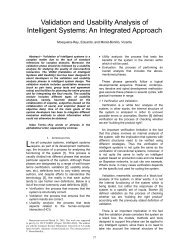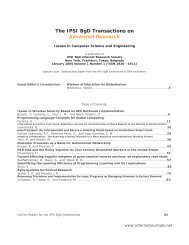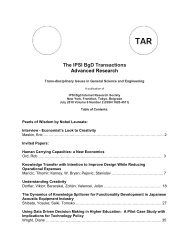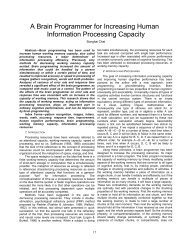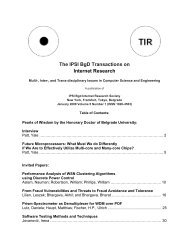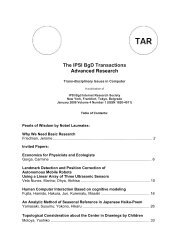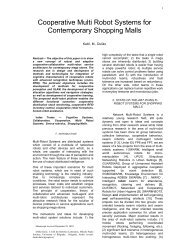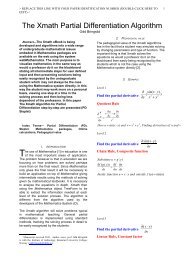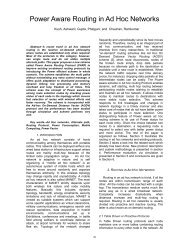The IPSI BgD Transactions on Internet Research - Welcome
The IPSI BgD Transactions on Internet Research - Welcome
The IPSI BgD Transactions on Internet Research - Welcome
Create successful ePaper yourself
Turn your PDF publications into a flip-book with our unique Google optimized e-Paper software.
currency c<strong>on</strong>versi<strong>on</strong> example, there are service<br />
providers called ‘xmethods.com’ that first publish<br />
services to a services directory. <str<strong>on</strong>g>The</str<strong>on</strong>g>n, we<br />
discover services that are useful to us and call<br />
those services directly, and the results are<br />
combined to form a new result useful to a user.<br />
This new applicati<strong>on</strong> using BPEL becomes<br />
another service that others might invoke directly<br />
or be composed with another service(s).<br />
<str<strong>on</strong>g>The</str<strong>on</strong>g> interacti<strong>on</strong>s between all the participating<br />
partners are described using the syntax of BPEL,<br />
and then deployed and executed by the BEPL<br />
engine. <str<strong>on</strong>g>The</str<strong>on</strong>g> Oracle BPEL Designer and Process<br />
Manager are tools that provide users with a<br />
development envir<strong>on</strong>ment to create, deploy, and<br />
execute applicati<strong>on</strong>s using BPEL. <str<strong>on</strong>g>The</str<strong>on</strong>g> BPEL<br />
Designer provides a visual modeling approach<br />
for developers to create new applicati<strong>on</strong>s. This<br />
approach is a form of Model Driven Architecture,<br />
where a system is designed with visual<br />
techniques and a code will be generated<br />
according to the visual diagrams. Here the visual<br />
diagrams are c<strong>on</strong>verted to BPEL syntax. A<br />
deployment tool is also provided through the<br />
BPEL Designer. <str<strong>on</strong>g>The</str<strong>on</strong>g> end product will then be<br />
executed by the BPEL engine, which will serve<br />
BPEL services. All of the tools and techniques to<br />
help build Service Oriented Programs will be part<br />
of the software factory.<br />
Figure 3. A Model-Driven Service<br />
Compositi<strong>on</strong> using Oracle Domain Specific<br />
Language for a Service Broker<br />
14<br />
5. ANALYZING THE FIVE INHERENT<br />
CAPABILITIES<br />
Based up<strong>on</strong> the case study results, we<br />
examine how the SOC paradigm provides the<br />
five inherent capabilities: interoperability,<br />
reusability, adaptability, interdependability, and<br />
agility, which are necessary for successful<br />
development of distributed, enterprise-level BISs.<br />
First of all, this Case Study 1 dem<strong>on</strong>strates<br />
that the SOC paradigm provides interoperability<br />
for integrating heterogeneous applicati<strong>on</strong>s. For<br />
example, the use case 3 in Table 1 employs two<br />
different types of web service classes:<br />
SupplierWS and RetailerDB2IxRetailWS. <str<strong>on</strong>g>The</str<strong>on</strong>g><br />
SupplierWS class was provided by the supplier<br />
and used for internal enterprise integrati<strong>on</strong>. <str<strong>on</strong>g>The</str<strong>on</strong>g><br />
RetailerDB2IxRetailWS class was provided by<br />
the retailer and used for integrating the supplier’s<br />
and the retailer’s applicati<strong>on</strong>s. <str<strong>on</strong>g>The</str<strong>on</strong>g>refore, the<br />
interoperability allows the software engineers to<br />
attempt to integrate heterogeneous systems for<br />
either EAI or B2BAI.<br />
Sec<strong>on</strong>dly, this Case Study 1 shows that the<br />
SOC paradigm provides reusability for software<br />
developers. In Table 1, the use case 3 employs<br />
the SupplierWS class that was implemented by<br />
the supplier for the use case 2. <str<strong>on</strong>g>The</str<strong>on</strong>g> use case 4<br />
uses the RetailerWS class that was implemented<br />
by the retailer for the use case 1. <str<strong>on</strong>g>The</str<strong>on</strong>g>refore, the<br />
reusability supports the software developers to<br />
reuse existing web services.<br />
Thirdly, Case Study 1 shows that the SOC<br />
paradigm provides (minimal) adaptability for<br />
software developers. Since the architectural<br />
pattern SOA in Figure 1 is also used for<br />
implementing BISs of both the retailer and the<br />
supplier, a developer can adjust the SOA for the<br />
supplier’s BIS if the developer understands the<br />
architecture of the retailer’s BIS. In additi<strong>on</strong>,<br />
since specificati<strong>on</strong>s of web services for B2BAI<br />
are published to a UDDI registry in Figure 2,<br />
software developers can access the registry and<br />
select web services for their new projects easily.<br />
<str<strong>on</strong>g>The</str<strong>on</strong>g> use of web service registries encourages<br />
software developers to adapt their distributed<br />
systems to the changed circumstances by<br />
allowing the discovery of existing web services.<br />
<str<strong>on</strong>g>The</str<strong>on</strong>g>refore, adaptability encourages the software<br />
developers to use the architectural pattern and<br />
existing services for developing a new BIS<br />
seamlessly. If the semantics of services are<br />
provided and automatic discovery of services <strong>on</strong><br />
demand is fully provided in the near future, the<br />
adaptability can be significantly improved.<br />
Fourthly, Case Study 1 shows that the SOC<br />
paradigm provides interdependability for software<br />
developers. <str<strong>on</strong>g>The</str<strong>on</strong>g>re are two different types of user<br />
interface: windows client applicati<strong>on</strong> and web<br />
client applicati<strong>on</strong>. Both of them use the same<br />
web service class RetailerWS. If the retailer<br />
requests a web service of the supplier, the<br />
retailer does not have to know the



